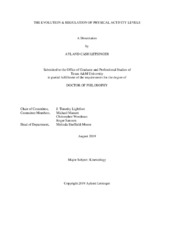| dc.description.abstract | Physical activity is a well-established preventative for many diseases, yet the average United States citizen does not engage in regular exercise. Thus, there is a need to understand the biological and environmental mechanisms that regulate physical activity adherence. Altered caloric intake has been shown to be a mediator of physical activity levels, with undereating leading to increased activity and overeating leading to decreased activity. The exact mechanisms through which diet alters activity are not yet known, but literature suggests the dopaminergic system as a primary central integration center where physical activity can be reinforced in times of need to allow the organism to acquire needed nutrients. As such, the purpose of this dissertation was to determine the following: 1) what single nucleotide polymorphisms are associated with physical activity regulation in humans and when in history did they mutate; 2) are the effects of diet on wheel running sustained through the lifespan; 3) how does a high fat/high sugar diet alter the production of relevant metabolites in the gut; and 4) are microbiota essential in mediating the relationship between diet and physical activity? Methods consisted of genetic mutation predictions, wheel running, diet interventions, metabolomics, and microbial rRNA sequencing. There was a total of 104 single nucleotide polymorphisms associated with physical activity in humans. The range of emergence was between 200-800 thousand of years ago. Caloric restriction proved to maintain wheel running throughout the lifespan, while overeating lead to progressive reductions. The gut metabolome was substantially
altered between a chow diet and a high fat/high sugar diet in mice including metabolites associated with sex hormones, neurotransmitters, and inflammation. Microbial transplants from high active animals in combination with improving diet increased wheel running quicker than an improved diet alone. Fecal transplantation without altering diet modestly increased microbe diversity of fecal pellets but did not change wheel running. A single genera, Lachnospiraceae, was correlated with improved physical activity during the treatment. However, the microbial and metabolite composition was primarily determined by diet with no clear distinction of treatment benefit. These results support the primary importance of diet and a supportive role of the microbiome on influencing levels of physical activity throughout the lifespan. | en |


